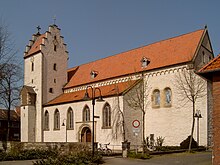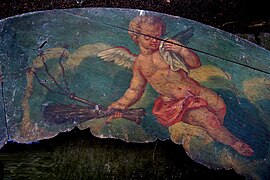St. Cornelius and Cyprian (Metelen)
The Catholic parish church of St. Cornelius and Cyprian is a listed church building in Metelen , a municipality in the Steinfurt district ( North Rhine-Westphalia ).
History and architecture
The former collegiate church of Metelen Abbey stands on a tree-lined church square. The two-bay , Romanesque stepped hall with straight closed choir is with a continuous gable roof covered. The wide west building was originally planned as a twin tower, but only the south tower was built. So far, no information is available about the foundation construction. The existing construction began at the end of the 12th century in the west. The nave with the north aisle and the choir was completed by the second half of the 13th century. The system was fundamentally rebuilt by Emil von Manger from 1856 to 1858 . A south aisle was added, the portal restored and reinstalled. The north aisle was aligned with the southern one. A sacristy was added as an eastern extension of the aisle. Instead of two arched windows, a Romanesque rose window was inserted into the east wall of the choir . The floor was lowered considerably in 1934, and the original extent of the nuns' gallery was excavated. A major renovation was carried out from 1957 to 1961. A pen chamber was added in 1989.
The massive west facade of the quarry stone building is adorned with a stepped gable . The basement of the tower is integrated into the facade. The walls are structured by arched windows and blind areas with three or five-part arched friezes on small consoles . The central three-window group with the raised central window is remarkable, it is decorated with inserted columns and round bulges. On the side of the square tower with a stepped gable, a small stair tower with a raised brick floor is added. The exterior of the nave is essentially determined by the two-lane pointed arch windows from the 19th century. Round arch friezes are visible on the Romanesque outer walls above the pent roofs of the side aisles. The round arched south portal is surrounded by a box frame made of sandstone blocks. The arches are covered with bulges above the leaf capital frieze. The west and north portal are rounded. The north portal is decorated with set columns and a bulge in the archivolt . The portals were partially renewed from 1856 to 1858. The east wall steps forward by one wall, the gable was renewed in brick. The windows of the south wall of the choir were reconstructed between 1956 and 1961.
Inside, the scheme of the hall church is presented in a bound order . The main supports are tiered several times towards the central nave. The semicircular templates and corner services with leaf capitals take up the bulging supports of belts and shield arches with base-like attachments. The round bar ribs of the domical vault are underlaid with angular edges. The side aisles are groin vaulted . During the renovation from 1957 to 1961, parts of the garments of two arched windows of the original outer walls were exposed in the southern high nave wall of the eastern central nave yoke . The collegiate women's gallery stands between the flanking basement of the tower . It originally extended to the western intermediate pillar of the nave and probably also included the northern aisle. In the three-aisled, two-bay substructure, groin vaults rest over sturdy pillars. The tower rooms on the ground floor are also vaulted with groin vaults. The finally built choir is characterized by its rich architectural decoration. The choir east wall is deepened and emphasized by multi-tiered pillars. Above the surrounding, niche-like blind arcades with wall benches, there is a cornice with head masks on the longitudinal walls. On the south side, half-figures, mythical creatures, angels, martyrs and knights can be seen between curly foliage. An eight-part domical vault with a Christ head as a keystone was drawn in. The vault paintings were added in 1961, at the same time the color of the capitals of all pillars was restored.
Furnishing
- The font of the younger Bentheim type is from the second quarter of the 13th century. The cylindrical basin is provided with palmette tendrils and a dew-shaped frieze.
- The delicate, almost life-size wooden crucifix was made at the beginning of the 12th century. The arms were added around 1950.
- The larger than life sandstone figure of the Evangelist Johannes comes from the workshop circle of the south portal at the cathedral in Münster around the middle of the 13th century, a second larger figure has been in the paradise of the cathedral since 1934.
- The sandstone St. John the Baptist from around 1440/50 is an excellent work under the influence of Burgundian sculptors. The figure is processed on the left, the right hand has been added. From 1967 to 1969 the medieval second version was uncovered and supplemented.
- The Pietà with beautifully lined folds, made of Baumberger sandstone, was created around 1440/50
- The crucifixion group is a work from around 1500, it shows the angel and the devil as the soul bearer of the thief . The group has been revised and the crosses have been renewed. The group was originally set up on the church square. (see photo)
- St. Anna selbdritt was carved around 1500 and later given a disfiguring color version.
- Some life-size figures, including the church patrons Cornelius and Cyprianus, date from the Baroque period .
- Some representative sandstone epitaphs with the coats of arms of former abbesses are exhibited. That of Cornelia Droste zu Vischering † 1732, shows a relief of the cross. The epitaph of Anna von Ketteler zu Sythen from around 1730 shows the penitent Magdalena.
- Several sandstone abbess crosses are from the 17th century.
Holy grave
The collegiate church has remains of a holy grave from the baroque period. The current inventory comprises a whole arch consisting of two halves belonging to one another and a half arch without the corresponding counterpart as well as a risen Christ. The arches with their mortise were inserted into a vertical (no longer existing) section of the grave backdrop. The backdrops are painted with putti , each of which has two instruments of suffering. These are lance and goblet, hammer and tongs, and rod and flagellum. In addition, parts of the suspension throne for the Holy of Holies still exist , which consists of boards covered with brocade fabric and was assigned to the Holy Sepulcher due to its design. The tradition of erecting a holy grave did not end with the abolition of the Metelen monastery, but, as contemporary witnesses show, continued into the 20th century. However, the custom of the arms of canons to guard the Holy Sepulcher ended. The backdrop arches with the putti were replaced over time by those showing moss-covered rocks and painted grave guards. The appearance of this Holy Sepulcher in the 20th century is documented by a colored drawing in the archives of the Metelen political community. There is no evidence whatsoever of the whereabouts of the Holy Sepulcher with the painted guards, they were still stored in the church's attic for a while after the liturgical reform and were then probably disposed of.
( see also: St. Magnus (Everswinkel))
The Holy Sepulcher was exhibited in 2016 on the occasion of the Memorial Day. To this end, the political municipality of Metelen issued a color-illustrated information leaflet. In 2018, the backdrops were taken over from the Museum Religio in Telgte and stored.
Pen chamber
The following items of equipment are kept in the so-called pin chamber
- A sandstone Pietà is a work from around 1480.
- St. Sebastian from oak was carved around 1500. The original version was uncovered in 1982 and the left hand was added at the same time.
- Anna's own third, made of oak from around 1520, is missing the baby Jesus and Anna's left hand.
- At St. Cornelius made of oak from the 16th century, the original version was exposed in 1982 and the ferula and the left hand were added.
- The passion column from the beginning of the 16th century is badly weathered, it was restored in 1960. The cock was added in 1973.
- The saints Joseph from oak and Dorothea and Agatha from sandstone were created in the 18th century.
- The wooden core of a reliquary in the form of a bursa from the 10th century is covered with gilded copper sheet and set in a cross shape with precious stones and rock crystals. Some of the stones are lost. The center stone was replaced with a baroque copper engraving under glass depicting the Madonna .
organ
The organ , a slider-drawer instrument with 36 registers and three manuals and pedal , was built in 1992 by the organ builder Siegfried Sauer (Höxter-Ottbergen). It is equipped with two effect registers, the Zimbelstern and the glockenspiel. With the exception of the solo work, the action and coupling work mechanically.
|
|
|
|
|||||||||||||||||||||||||||||||||||||||||||||||||||||||||||||||||||||||||||||||||||||||||||||||||||||||||||||||||||||||||||||||||||||
- Coupling : II / I, III / I, III / II, I / P, II / P, III / P
Bells
A complete monastery and parish bell has been preserved.
| No. | Surname | Casting year | Caster | Nominal | inscription |
| 1 | 1659 | Joh. Fremy | d 1 (+7) | ||
| 2 | 1741 | Johann Schweys | it 1 (+2) | ||
| 3 | around 1400 | es 1 (−3) | |||
| 4th | 1629 | Blasius Hemony | ges 1 (+5) | ||
| 5 | f 2 (−1) | ||||
| 6th | ges 2 (−2) |
literature
- Georg Dehio , under the scientific direction of Ursula Quednau: Handbuch der deutschen Kunstdenkmäler. North Rhine-Westphalia II Westphalia . Deutscher Kunstverlag , Berlin / Munich 2011, ISBN 978-3-422-03114-2
Web links
- History and photos (accessed May 20, 2012)
Individual evidence
- ↑ Flyer "The Holy Grave in Ss. Cornelius and Cyprianus Metelen", Metelen Municipality 2016
- ↑ Print edition of the daily newspaper for the Steinfurt district , local page Metelen, and also Münsterische Zeitung , local page Metelen, from 2013
- ↑ The Holy Sepulcher from Ss. Cornelius and Cyprianus Metelen , leaflet, written and edited by the Metelen municipality 2016.
- ^ Information from the Metelen municipal archive 2018
- ↑ Information on the organ
Coordinates: 52 ° 8 ′ 41.7 ″ N , 7 ° 12 ′ 46.2 ″ E






